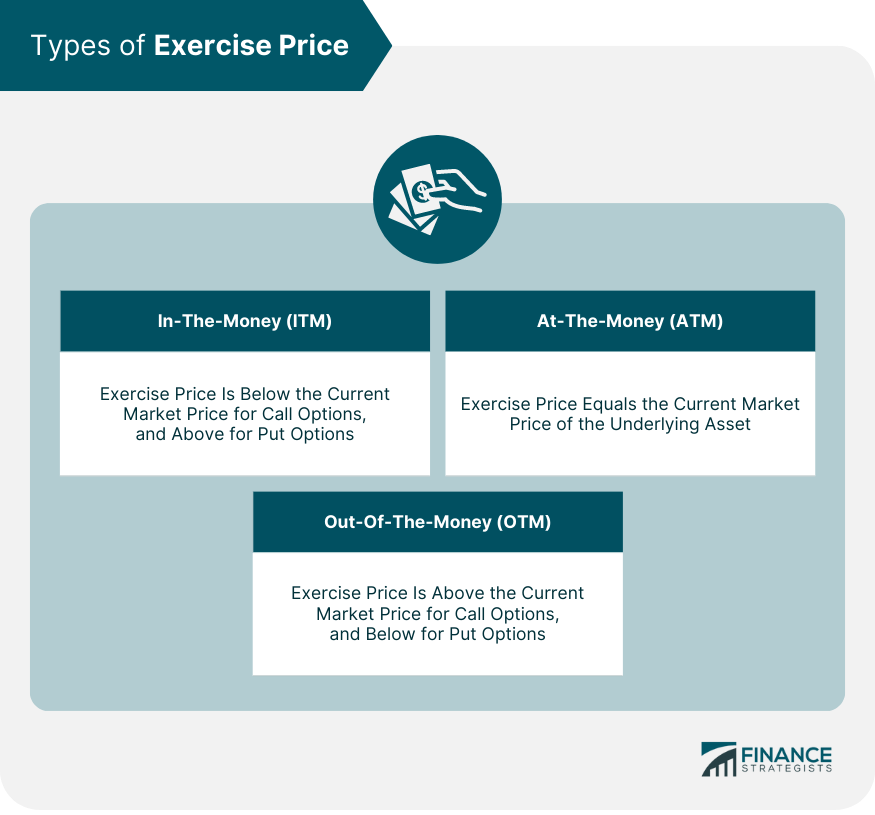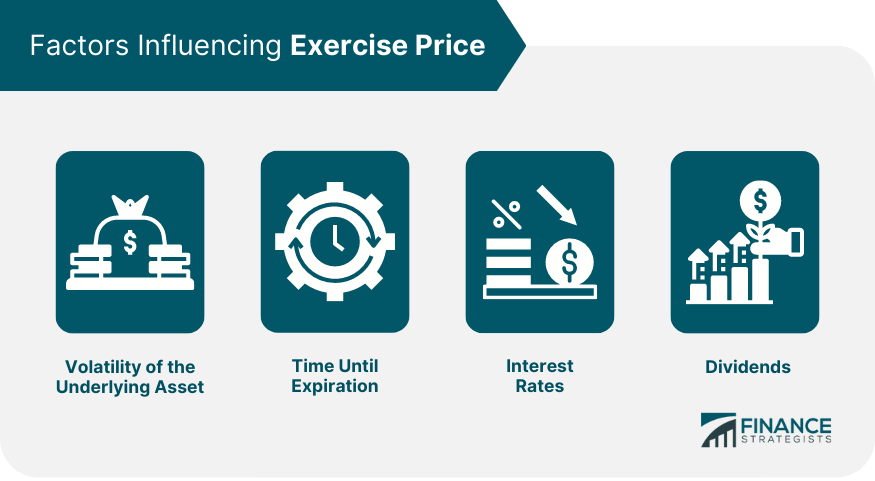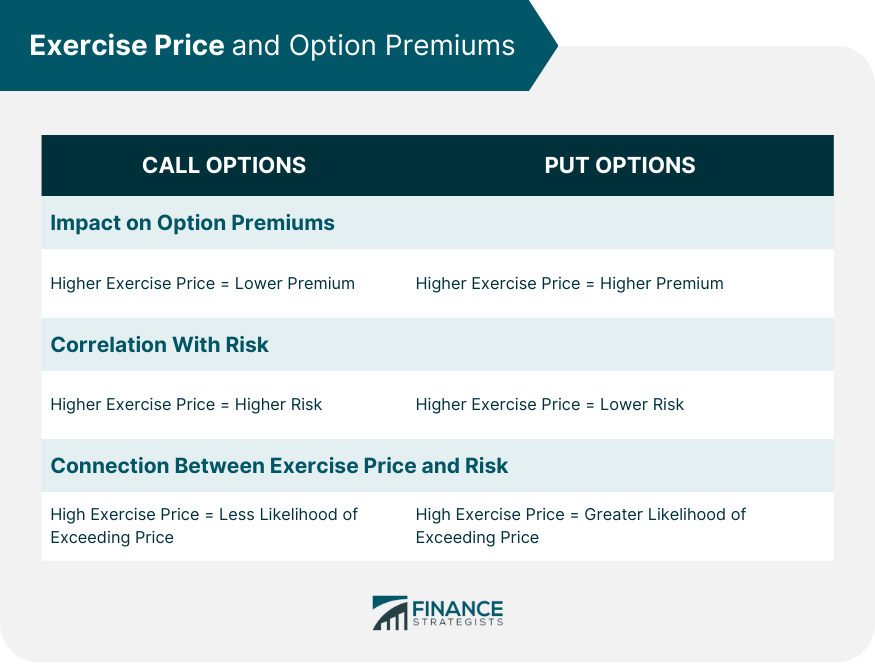The exercise price, also known as the strike price, is a predetermined price at which an option contract can be exercised. It is the price at which the option holder has the right, but not the obligation, to buy or sell the underlying asset. The exercise price is a crucial parameter in options trading. It directly influences the profitability of an option contract and determines whether or not the option will be exercised. It is the primary factor that differentiates valuable options from worthless ones. Investors and traders need to understand how it works, as its proper analysis can lead to significant financial gains or losses. An options contract gives the holder the right, but not the obligation, to buy or sell the underlying asset at a specified price (the exercise price) before a certain date (the expiration date). The buyer of the option pays a premium to the seller (or writer) for this right. The exercise price plays a critical role in options contracts. It is the price at which the underlying asset will change hands if the option is exercised. The buyer of a call option hopes that the market price of the asset will rise above the exercise price before expiration, while the buyer of a put option hopes that the market price will fall below the exercise price. The relationship between the exercise price and the market price of the underlying asset determines the intrinsic value of an option. For call options, if the market price is above the exercise price, the option has a positive intrinsic value (in-the-money). If the market price is below the exercise price, the option has no intrinsic value (out-of-the-money). Conversely, for put options, if the market price is below the exercise price, the option is in-the-money; if it's above, the option is out-of-the-money. In-the-money exercise price refers to a situation where the exercise price for a call option is below the current market price of the underlying asset, or where the exercise price for a put option is above the current market price. ITM options have intrinsic value. At-the-money exercise price occurs when the exercise price is equal to the current market price of the underlying asset. ATM options have no intrinsic value but may still have time value. Out-of-the-money exercise price refers to a situation where the exercise price for a call option is above the current market price or where the exercise price for a put option is below the current market price. OTM options have no intrinsic value. The volatility of the underlying asset is a key determinant of the exercise price. Higher volatility implies a higher risk and, thus, a higher exercise price. The time until expiration also influences the exercise price. Options with longer durations typically have higher exercise prices, reflecting the greater potential for price movements over time. Interest rates have an impact on the exercise price. When rates rise, call option exercise prices increase, and put option exercise prices decrease, reflecting the cost of capital tied up in the option. Dividends affect the exercise price too. The exercise price of call options tends to decrease with expected dividends because the price of the underlying asset is expected to decrease by the dividend amount on the ex-dividend date. Conversely, the exercise price of put options increases with expected dividends. The relationship between the exercise price and options premiums is a vital concept in options trading. Generally, the higher the exercise price for a call option, the lower the premium because the probability of the option being exercised decreases. Conversely, for put options, a higher exercise price typically results in a higher premium. The exercise price of an option significantly impacts the level of risk associated with the contract. For example, a call option with a high exercise price is riskier than one with a low exercise price because there's a smaller likelihood that the underlying asset's price will exceed the high exercise price before expiration. This risk is reflected in the option's premium. The exercise price plays a critical role in various options strategies. For instance, in a covered call strategy, an investor sells call options on an asset they already own. They might choose an exercise price above the current market price to earn premium income and potentially sell the asset at a profit. In a protective put strategy, an investor buys put options as insurance against a drop in the price of an asset they own. They might choose an exercise price close to the current market price to provide maximum protection. Selecting the appropriate exercise price is a crucial part of successful options trading. It requires careful analysis of market conditions, the underlying asset's price trends, and the investor's risk tolerance and investment goals. Option holders have the right to exercise their option if it is profitable to do so. For call options, this would mean the market price of the underlying asset is above the exercise price. For put options, this would mean the market price is below the exercise price. Early exercise refers to exercising an option before its expiration date. This typically happens when the option is deeply in-the-money, and there is little time value left, or when a significant dividend is expected. Some exchanges automatically exercise in-the-money options at expiration, a process known as automatic exercise. This process ensures that option holders do not inadvertently lose the intrinsic value of their options at expiration. The exercise price, like other aspects of options contracts, is subject to regulatory oversight. Regulatory bodies like the Securities and Exchange Commission (SEC) in the U.S. or the Financial Conduct Authority (FCA) in the U.K. ensure that the process of setting exercise prices is transparent and fair. Regulatory bodies do not directly determine exercise prices but set rules and guidelines for how they should be calculated and disclosed. They also monitor market activity to prevent manipulation or fraudulent practices related to exercise prices. Exercise price is a fundamental concept in options trading, influencing the profitability, risk, and strategies associated with option contracts. It determines the price at which the underlying asset will change hands if the option is exercised. The relationship between the exercise price and market price determines the intrinsic value of an option. Various factors, including volatility, time until expiration, interest rates, and dividends, impact exercise prices. Higher exercise prices generally result in lower premiums for call options and higher premiums for put options. Exercise price plays a crucial role in option strategies such as covered calls and protective puts, and selecting the appropriate exercise price is essential for successful trading. Regulatory bodies ensure transparency and fairness in setting exercise prices within the legal framework of options trading.What Is Exercise Price?
Understanding the Basics of Exercise Price
Concept of Options Contracts
Role of Exercise Price in Options Contracts
Relationship Between Exercise Price, Market Price, and Intrinsic Value
Types of Exercise Price
In-The-Money (ITM) Exercise Price
At-The-Money (ATM) Exercise Price
Out-Of-The-Money (OTM) Exercise Price

Factors Influencing Exercise Price
Volatility of the Underlying Asset
Time Until Expiration
Interest Rates
Dividends

Exercise Price and Option Premiums
How Exercise Price Affects Option Premiums
Correlation Between Exercise Price and Risk

Exercise Price and Option Strategies
Different Option Strategies and Their Relevant Exercise Prices
Choosing the Right Exercise Price for Different Strategies
Exercise Price and Option Exercise
Right to Exercise Option
Early Exercise of Options
Automatic Exercise of Options
Regulatory Aspects of Exercise Price
Legal Framework Surrounding Exercise Price
Role of Regulatory Bodies in Determining Exercise Prices
Bottom Line
Exercise Price FAQs
The exercise price, also known as the strike price, is the price at which an option holder can buy (in the case of a call option) or sell (in the case of a put option) the underlying asset when the option is exercised. It's a fundamental concept in options trading.
The exercise price directly influences an option's premium. For call options, a higher exercise price generally leads to a lower premium because the likelihood of the option being exercised decreases. Conversely, for put options, a higher exercise price usually results in a higher premium.
The relationship between the exercise price and the market price of the underlying asset determines an option's intrinsic value. For call options, if the market price is above the exercise price, the option has a positive intrinsic value. If the market price is below the exercise price, the option has no intrinsic value. The opposite is true for put options.
Volatility is a key determinant of the exercise price. The higher the volatility of the underlying asset, the higher the exercise price. This is because greater volatility implies higher risk, which is reflected in a higher exercise price.
Understanding the exercise price is crucial for investors because it directly influences the profitability of an option contract. The relationship between the exercise price and the underlying asset's market price determines whether the option will be in-the-money or out-of-the-money and whether it will be profitable to exercise the option. It's, therefore, essential to understand this concept to make informed trading decisions.
True Tamplin is a published author, public speaker, CEO of UpDigital, and founder of Finance Strategists.
True is a Certified Educator in Personal Finance (CEPF®), author of The Handy Financial Ratios Guide, a member of the Society for Advancing Business Editing and Writing, contributes to his financial education site, Finance Strategists, and has spoken to various financial communities such as the CFA Institute, as well as university students like his Alma mater, Biola University, where he received a bachelor of science in business and data analytics.
To learn more about True, visit his personal website or view his author profiles on Amazon, Nasdaq and Forbes.















